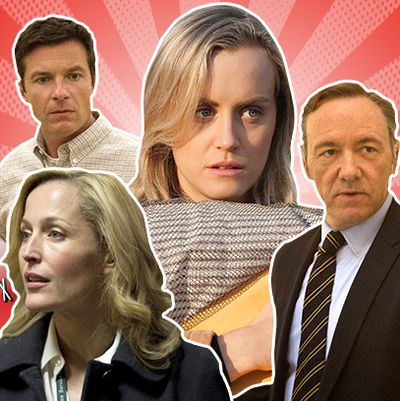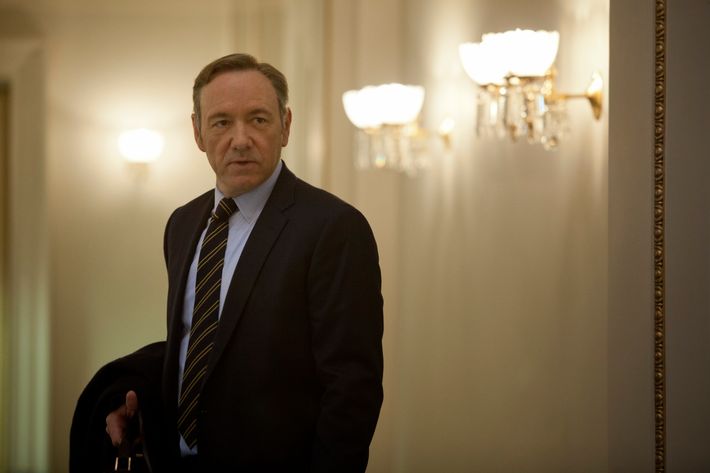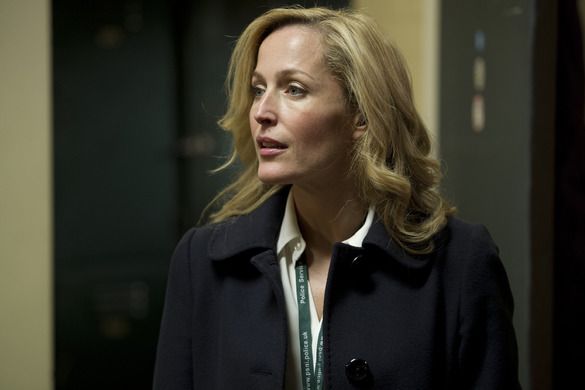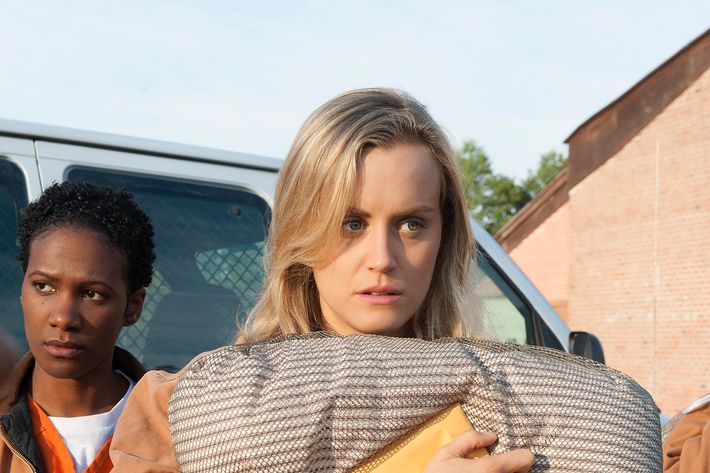
Vulture has spent a good chunk of this midsummer week examining the rapidly growing Big Three subscription streaming “networks”: We’ve analyzed Hulu Plus and Amazon Prime Instant Video, and today we wrap up by turning our eyes to the oldest and biggest of them all, Netflix. And while complaining about what’s not on Netflix is something of a national pastime, its dominance in the streaming space cannot be denied: On most days, Netflix accounts for fully one-third of all video streaming usage, more than doubling No. 2 YouTube. But as we’ve seen this week, Hulu and Amazon are starting to make strides against the top dog. So, despite the fact that Netflix earned more major Emmy nominations for its original programming than all but eight broadcast and cable networks, its execs can’t afford to sit on their lead. Here’s where the service stands.
Subscribers: 29.8 million in the U.S.; 7.6 million worldwide (up from 20 million at the start of 2011).
Library: Like Amazon, Netflix won’t detail exactly what’s in its digital lockers. “There are thousands of hours of TV shows and movies to watch on Netflix,” a Netflix rep told us. “We don’t disclose the exact number because our offering changes all the time as titles go in and out of window.”
Hit TV shows: Netflix streams 27% of Nielsen’s top 75 shows from last season.
Content pipeline: Its roster of originals includes the Emmy-nominated House of Cards; season four of Arrested Development; Jenji Kohan’s prison dramedy Orange Is the New Black; Eli Roth’s supernatural mystery series Hemlock Grove; plus upcoming offerings from Ricky Gervais (the comedy Derek) and Andy and Lana Wachowski (the sci-fi series Sense8).

The big picture: Just a few years ago, Netflix looked like it was in trouble. Despite amassing an army of loyal users since launching in 1999, the groundbreaking DVD delivery service had become vulnerable to the increasing popularity of instant streaming, which was suddenly making even Blu-ray discs look as dated as 8-tracks. And while Netflix had anticipated the effect that high-speed internet service would have on its original business model when it debuted the site’s “Watch Instantly” feature way back in 2007, the company’s early streaming library was decidedly meh. The titles improved steadily, and subscribers arrived in droves. But in 2011, Netflix made a major blunder by spinning off the streaming part of the site into its own entity. Just type “Netflix fiasco” into your browser’s search bar if you’ve somehow forgotten the New Coke–level disaster that was Qwikster.
Barely two years later, all that drama seems a distant memory. Under the leadership of CEO Reed Hastings and chief content officer Ted Sarandos, Netflix has reinvented itself as the dominant subscription streaming service, one with seven times as many paid subscribers as Hulu Plus and ambitions to become the HBO for the digital generation. It’s the only player with original series generating sizable buzz, and last week, it became the first to snag Emmy nominations in the major categories. As we’ve reported this week, it has rivals intent on giving it a challenge, but for now, it’s playing a different level of ball than the others. Mike Olson, a media analyst at Piper Jaffray, says Netflix is benefiting from what he calls a “first-mover advantage.” For a while, Netflix was “the only one with good content and also integrated with all major digital devices,” he says. That’s no longer the case, but because “Netflix has the biggest subscriber base, they can afford premium content,” Olson explains. “It’s a cycle. If they can keep attracting more subscribers, they can afford more content, which lets them get more subscribers. It’s a good place to be in.”
And while Netflix is not yet in the same ballpark in terms of profits or programming mass, it doesn’t seem far-fetched to think of them as having the same sort of brand appeal to streaming consumers that HBO has to potential premium cable subscribers. “In a world of increased clutter and fragmentation, the only thing that lets anyone stand out is high-quality original content,” says BTIG analyst Rich Greenfield. By making an early splash with premium cable-level shows so early, Netflix “is following a time-worn model,” the same one which transformed HBO, Showtime and AMC from movie channels to Emmy magnets. Netflix is also trying to ensure its survival: As studios and networks demand more and more for their programming, and in some cases choose to retain streaming rights for themselves, there’s no guarantee Netflix’s content pipeline won’t be impacted in future years. Shows such as Orange Is the New Black or House of Cards are a way to make sure Netflix has something of value to offer subscribers going forward. Execs at the company are also fully aware of the fact that HBO could dramatically shake up the streaming space were it to ever decide to let consumers bypass cable and satellite companies and buy access to its HBO GO service. “The goal is to become HBO faster than HBO can become us,” Sarandos told GQ in February.
Acquired content: As Netflix subscribers know all too well, the service’s library lately has been very much in flux. In May, for example, more than 1,000 (some reports say closer to 2,000) movie titles (from Goldfinger to Big Daddy) simply vanished after a licensing deal with pay TV network Epix expired. Kiddie Netflix addicts jonesing for their Dora the Explorer fix had to quit cold turkey when Viacom and Netflix went through a messy breakup in late spring. Title churn is a fact of life with all streaming services (and with cable networks such as Showtime, for that matter), but there’ll be more of it on Netflix in coming months as the service continues its rapid evolution from distributor to curator. “When we first started licensing content for streaming, we were trying to figure out what customers wanted to watch,” Sarandos tells Vulture. “We were testing the waters in terms of rights that had not exploited yet.” Back in the early days, that meant lots of experimentation and even some risk-taking. “One of our first big movie breakthroughs was Pan’s Labyrinth,” Sarandos says. “HBO passed on it because it was foreign language, so we made the deal for it. And it ended up being an Oscar nominee, and it did huge viewing for Netflix.” The same was true with TV: “We licensed big swaths of content from each supplier, trying to figure out what worked and didn’t,” Sarandos explains. “In that process, Netflix was kind of a distributor, versus what really are, which is a programmer.” As Netflix continues its push into originals, it will continue to reallocate some its resources, taking money that might have gone to acquiring library content and putting it into the next House of Cards. “We’re less interested in big bundles of content, and far more interested in curating the best shows from any given network,” Sarandos says. “We’re not striving to get everything, because in a pure subscription model, it’s not really economically feasible. If he’d been able to, Sarandos said he would’ve jumped on a deal to keep Spongebob on Netflix. But Viacom wanted Netflix to “do a deal … to basically take all their output.”
But while lots of blog posts get written whenever movies and TV shows disappear from Netflix, the service still has a massive library of content, with new fare coming online all the time (as many as 500 titles every month, the company has told reporters).Yes, Viacom content from networks such as Nickelodeon and MTV is no longer streaming. Those Epix movies are gone. But Netflix will be adding content from Disney/Pixar and DreamWorks over the next three years as massive output deals recently struck with those studios come online. A deal in January brought Adult Swim titles such as Childrens Hospital and Robot Chicken to Netflix, as well as TNT’s reboot of Dallas and older shows such as The West Wing. And earlier this month, CBS renewed and bulked up its Netflix deal, keeping Star Trek and Cheers while adding CSI: NY and other series. A Piper Jaffray analysis shows that Netflix streams a higher percentage (14%) of the top 50 highest grossing movies released over the past three years than Amazon Prime (10%) and Hulu Plus (none) combined. Overall, the analysts we spoke to said that while Hulu dominates with current episodes of TV shows, Netflix has the deepest catalogue of back seasons. “If you’re looking for a way to watch a show from start to finish, the only option for most shows is Netflix,” Piper Jaffray’s Olson says. And looking at both TV shows and movies, “They have many more significant titles in their library,” he adds. Sarandos also argues that, depite Hulu’s strength with international series, Netflix’s global content is just as strong, if not stronger, citing acquisitions such as the BBC 2–produced Gillian Anderson drama The Fall as backup.

Original content: Netflix debuted its first original series, Lilyhammer, in February 2012. A co-production with Norway’s Norwegian Rubicon TV AS, the Steven Van Zandt dramedy was a hit with Norwegians, but didn’t cause much of a stir stateside (though it’s been renewed for a second season). Most TV historians will likely cite the debut of House of Cards as the start of the Netflix original production era. Unless you don’t pay attention to pop culture at all, you know the basics of the show: Spacey, Wright, Fincher, good review, Emmy nominations. Sarandos is not shy in his description of how far out of the park Netflix hit it with House. “It really took The Sopranos to define HBO as a gold standard of original content,” he says. “We kind of came out of the box with The Sopranos, and that’s a good thing.” We’ll leave it to critics to debate whether or not House is anywhere near the same level of Sopranos, but the Netflix show absolutely feels like it would be right at home on either Showtime or HBO. And the subsequent content to come from Netflix in the past year — the gory Hemlock Grove, the boundary-redfining season four of Arrested Development, the amazing Orange Is the New Black — all feels like it could work on at least one of the major pay cable networks (including Starz). While Sarandos hasn’t hidden his aspirations to be the HBO of streaming, he’s not ready to declare just what a “Netflix show” is. “I’m not looking to find a single show to define Netflix,” he says. “That’s almost the opposite of what we’re trying to do. Our brand is all about personalization.” He points to the diversity of the current slate as a strength. “The beauty of the first four shows is, there isn’t much crossover with any of them,” Sarandos says. “The people who watched Hemlock Grove? Very few of them watched House of Cards. But they’re both successful.” He was also nothing but positive in describing how well rebooting Arrested has gone. “It’s an unqualified hit in every way,” he says, repeating recent comments by producers and other Netflix execs that season five will happen once scheduling can be worked out.
As was well-documented in the publicity run-up to House, Netflix is taking a hands-off approach to its creators; that doesn’t mean it doesn’t give any notes at all. “The mandate that I have is that there are no arbitrary notes,” he says. “If it’s a question of, “Should someone have a mustache?”, I leave that to creators… [But] when we can really add value, we do. We did shows with three [creators] whose m.o. historically is they’re difficult to work with. We found them spectacular to work with. We only argued with things that mattered. And they loved having those discussions.” What’s more radical to Netflix’s development process is its decision to do away with the usual piloting process. Yes, Sarandos does take meetings, a “very high volume of pitches,” he says. (Netflix is spending lots and lots of money; it’s no surprise Hollywood wants some that money.) While the meetings are “very traditional pitches” in that talent comes in and walks through an idea, the rest of how Netflix does things is very different. Its shows have gone straight to series, with no templates filmed in advance. Even HBO makes pilots for most of its shows. “I think it’s much lower risk to ask the producers to put a little bit of their own development into a project, and we’ll go straight to seasons … instead of playing the odds game, where we make 20 pilots and make two and one sticks,” Sarandos says. “That’s a good business? I don’t think it is. I’d much rather end up with 20 hours of programming that people can watch.”
Sarandos doesn’t act like he’s found The Solution to making good TV; in fact, he admits his whole approach is something of an experiment. “What we’re testing the waters on is, without the protection of the pilot system and the development system, can we keep producing high quality programs? I’m betting that you can,” he says. “I’m betting that there are great stories and great storytellers. And as long as we do a great job of matching them up well, then we’re going to keep doing this. By going straight to series, the people have a great story to tell will bring it to us first.” Analysts have predicted that Netflix will soon devote up to 10 percent of its overall budget to originals, but Sarandos says he’s not there yet. “Right now, we don’t have a stated goal for how many shows we want,” he says. “That said, I could definitely see us doubling our current output. Over the next couple years, I could see us taking it has high as 20.” Earlier this week, Sarandos and Hastings said Netflix was looking to get into documentary production and stand-up specials, further copying the premium cable playbook. When asked, he also told Vulture he could even see experimenting with telenovelas or soaps, given Netflix’s growing international presence and relationships with Latin American broadcasters. Overall, the mandate for Netflix original content seems to be: more, and all kinds. “The more we’re exclusive and original, the less I’m worried about any particular competitors,” he says. “You might love Showtime because you love Homeland. But you can’t get if you switch to HBO. Competitive differentiation becomes more and important for us, like it has for those guys.”
What analysts say: Both of the analysts we spoke with, Olson and Greenfield, were very bullish on Netflix’s status relative to the other streaming players. “We think Netflix can reach 40 million domestic subscribers by the end of 2015,” Greenfield says. He says Netflix is far ahead of its rivals with “iconic programming,” which is what he says “drives people to sign up for” streaming services. “They’re the only one who have it,” he says. “Amazon is starting to do it, Hulu is starting to do it. But they’re just starting. Netflix is the trailblazer. If you have an [internet-connected] device, you want Netflix.” (Netflix, by the way, replaced its usual quarterly analysts’ call this week with a streaming Google Hangout in which Greenfield and CNBC’s Julia Boorstin grilled company execs for a half-hour.) Olson is equally blunt about Netflix’s lead over rivals. “In all three categories — movies, TV shows, originals — Netflix has the best offerings,” he says.
Still, Greenfield notes that, even while it’s got a head start on other streaming services, “there’s very little original programing relative to an HBO.” And for all the buzz and good reviews and Emmy nods, Greenfield says there’s just no comparing a show such as House of Cards to an HBO blockbuster such as Game of Thrones or True Blood. “They don’t have that breakout hit yet,” Greenfield says. What’s more, Michael Pachter, a senior analyst at Wedbush Securities, told CNBC in May that he believes that, in the long-term, Netflix could be in for rough times in coming years. “The fact is these guys don’t control their expense structure at all,” he told CNBC. “The content owners want more money and Netflix’s only recourse is going to be to raise prices. When they do that, their growth is going to slow.” He also thinks Netflix will be in trouble if it doesn’t start owning its content, rather than leasing it. “Someone else produces content, Netflix buys exclusive rights for a very limited period of time and then Netflix doesn’t own the content anymore,” Pachter said. “This is not the same as the HBO model. They are nothing like HBO. They have a three-year window to show House of Cards. After that nothing. They don’t own it, they can’t exploit it further unless they pay more. That’s not ownership of content.”

Bottom line: Netflix may not be HBO, but it is the closest thing to HBO in the streaming space (at least until HBO decides to make HBO GO a stand-alone product). No one service will ever satisfy every user, but for most people looking for a mix of first-run movies and TV shows, as well as a smattering of compelling originals, Netflix is a very compelling choice. The biggest question remains whether it can scale up the number of its original offerings quickly while matching the quality of its early efforts.

